 |
This timeline is a work in progress! Please check back regularly for new additions!
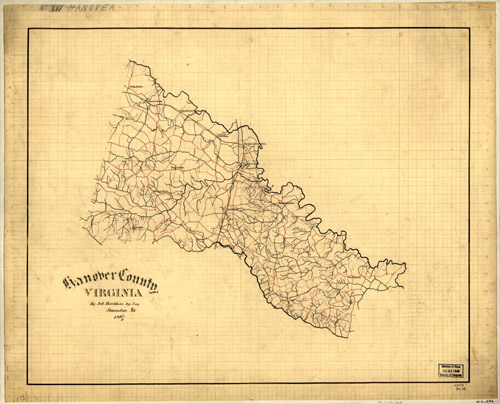 Hanover County, Virginia by Jedediah Hotchkiss, 1867. Map courtesy of LOC.gov. Hanover County, Virginia by Jedediah Hotchkiss, 1867. Map courtesy of LOC.gov. |
 |
Hanover County Was Founded on November 26, 1720:
300 Years and Counting...
2020 marked the 300th birthday of Hanover County.
|
 |
May 14, 1607
104 male settlers land at the site they name "James Cittie" (Jamestowne, James Town, Jamestown) and establish the first permanent English settlement in North America. |
 |
June 21, 1607
First public church service held at Jamestowne. This inaugurated the Colonial Church of Virginia, an extension of the Established Church in England (Anglican Church, later the Episcopal Church). |
|
 |
May 11 Virginia Company's "Great Charter" to George Yeardley required colony be divided into four "incorporations" (boroughs), "the chief City called James town, Charles City, Henrico and the Burrough of Kiccowtan (Kecoughtan)" with 1,500 acre grants.
George Yeardley brings The Charter of Grants and Liberties to form a new government in which white men of property get to pick representatives to make laws for themselves in an assembly meeting at Jamestowne. |
 |
July 30 The first Representative Legislative Assembly in Virginia (House of Burgesses, today's General Assembly) meets in the "quire" (choir) in Jamestowne church; its first law requires tobacco to be sold for at least three shillings per pound. |
 |
August The first "recorded" Africans (likely from today's Angola) arrive in Jamestowne, traded off of an English ship, the White Lion, which landed at Point Comfort. Some of these Africans are treated as indentured servants and work several years before earning their legal freedom; others likely remained enslaved. |
December 4 The first English Thanksgiving takes place at Berkeley Hundred when 35 settlers with Captain John Woodlief arrive after 75 days at sea on the Margaret, and celebrate "a day of thanksgiving to Almighty God," reading from the Book of Common Prayer. This event was intended to occur annually into perpetuity, but an Indian massacre in 1622 curtailed future celebrations.
|
 |
|

Virginia's first counties are born Eight "units" of local government (shires, often called counties) are chartered by the House of Burgesses, with the approval of the appointed royal governor: The four incorporations are Henrico, Charles City, James City, and Elizabeth City (replacement for the "heathen" name of Kecoughtan). Four new counties were also incorporated: Accomack, Charles River (renamed York in 1643), Warrosquyoake (renamed Isle of Wight in 1637), and Warwick River (now part of Newport News).

March 2 "BE it further enacted and confirmed... ...that Charles River county (of which Hanover was a part) shall be distinguished by this name (the County of York)..." (I. Hen. St. at Large, p. 249) |
 |

November 20 "It is ordered that the upper part of Yorke county shall be a distinct county called New Kent, from the west side of Scimino creek to the heads of Pomunke and Mattaponie Rivers, and downe to the head of the west side of Poropotanke Creeke." Held at James Citti. (I. Hen. St. at Large, p. 388) |
 |

April 20 St. Paul's Parish formed from St. Peter's Parish in New Kent County, effective June 1, 1704. (The Vestry Book of St. Paul’s Parish, pp. xii, 593)
|
|
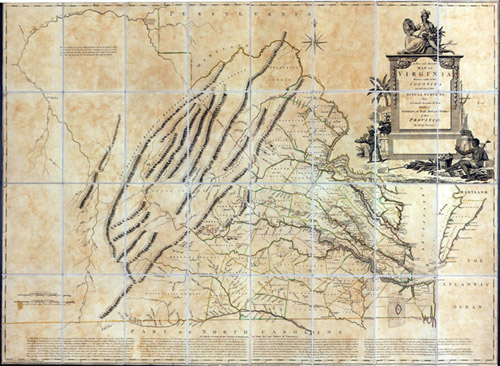 A new and accurate map of Virginia wherein most of the counties are laid down from actual surveys. With a concise account of the number of inhabitants, the trade, soil, and produce of that Province, by John Henry and Thomas Jefferys, published in London in 1770. Map courtesy of LOC.gov. A new and accurate map of Virginia wherein most of the counties are laid down from actual surveys. With a concise account of the number of inhabitants, the trade, soil, and produce of that Province, by John Henry and Thomas Jefferys, published in London in 1770. Map courtesy of LOC.gov. |
 |

Hanover County is formedNovember 26 "An Act of Dividing New Kent County", forms Hanover County from western part of New Kent, a part of St. Paul's Parish, effective May 1, 1721. It was named for King George I of England, who was Elector of Hanover in Germany when he came to the throne.
May 21 Hanover County's first court is held on "Plantation of Robert Jennings." Exact location has been lost to history, though it was close to the present Hanover Courthouse. ("Historic Structure Report Hanover Courthouse and Jail, Hanover, VA". pp 6, 9, 10) May: St. Martin's Parish is formed from western end of St. Paul's Parish, effective January 1, 1727, "...which lies between the north and South branches of pomonky River and also all that part of the said parish lying above Stone horse Creek in the County...". (The Vestry Book of St. Paul’s Parish, pp. 596, 597)
|
|
|
May 29 "Hanover’s First Native Son," "Founding Father," patriot, orator, and Virginia's First Governor, Patrick Henry is born to Rev., Colonel John and Sarah Winston (widow Syme) Henry at "Studley." Henry dies June 6, 1799 at his home Red Hill near Brookneal, Virginia.
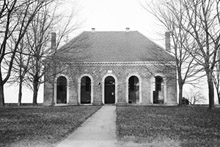 The Historic Hanover Courthouse The Historic Hanover Courthouse
in 1933 |
 |
Construction is begun on Hanover County's second courthouse, today’s Historic Hanover Courthouse. Keystone date of 1735 is likely the beginning of approval/planning for an "ordered courthouse." |
|
 |
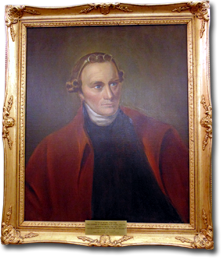 The portrait of Patrick Henry that hangs today in the Historic Hanover Courthouse The portrait of Patrick Henry that hangs today in the Historic Hanover Courthouse |
|
December 1: Louisa County formed. "...all that tract of land now deemed to be part of the said county of Hanover, lying above a straight course to be run from the mouth of Little Rockey creek, on the river Northanna, south, twenty until it intersects the line of Goochland county, be divided from the said county of Hanover, and be made a distinct county, to be called by the name of Louisa county." (V. Hen. St. at Large, pp. 208, 209) |
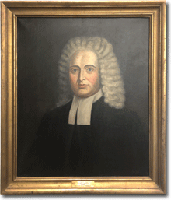 The Reverend Samuel Davies, which portrait hangs today in the Historic Hanover Courthouse The Reverend Samuel Davies, which portrait hangs today in the Historic Hanover Courthouse |
 |

April 15Samuel Davies is licensed by the Governor's Council in Williamsburg to officiate and preach as a dissenter Presbyterian, in and about Hanover County at four meetinghouses - Morris's Polegreen, Rice's at Page's Warehouse, Watkins' in Henrico and Leacy's in western Hanover. (Living on the Borders of Eternity by Robert Bluford, Jr.) |
 |
First volunteer company of militia raised in colony was established in Hanover as result of Samuel Davies' "war sermons" in March and July. Captain George Overton's First Virginia Militia had been formed and at a send-off meeting at Overton's home, after sermon, many more lined up to join. (Living on the Borders of Eternity by Robert Bluford, Jr., pp.404-408)
Act to pay Clergy in Virginia at rate of 16,000 pounds of tobacco per year is passed in Parliament.
|
|
|
July: First independent company of soldiers raised in Virginia was enlisted in Hanover County, commanded by Samuel Overton, after Braddock's defeat. (Virginia Migrations, Hanover County... ...Vol. 1..., pp. i - ii) |
 |
Virginia's House of Burgesses passes Two Penny Act, changing annual payment to Clergy to two cents per pound of tobacco as poor tobacco harvest had inflated prices. King George III vetoes Virginia law.
May 8: At the request of Captain Samuel Meredith, Samuel Davies preaches sermon to raise a company of militia: 35 men are turned away at the end. (Virginia Migrations, Hanover County... ...Vol. 1..., pp. i - ii) |
|
November 5: Parsons' Cause case: Court rules that the claim of the plaintiff, Reverend James F. Maury, is valid...but also rules that the Two Penny Act is "no law", and orders jury to set damages. Attorney for defense withdraws, Patrick Henry appointed to argue jury award phase.
December 1: Patrick Henry argues the jury award phase of the "Parsons' Cause" case, arguing that King George III and state-supported churches are tyrannical. Henry further argues that damages must be in fact awarded to the plaintiff, but that those damages need not be more than a farthing. Jury returns verdict awarding only one penny in damages.
This trial is considered one of the early steps on the Road to Revolution, as it is one of the first times that English law is openly contested in an American court. |
 |
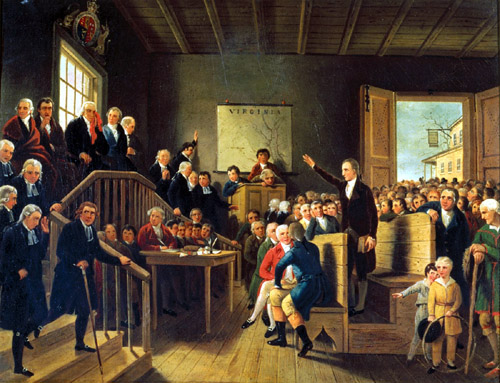 The Parsons' Cause by George Cooke, 1834 The Parsons' Cause by George Cooke, 1834 |
|

July 20: Hanover Citizens assemble at Courthouse to instruct representatives John Syme and Patrick Henry: The Hanover Resolutions, precursor of the Declaration of Independence, are adopted. (Virginia Migrations, Hanover County... ...Vol. 1..., p.ii)
"...We are free men; we have right to be so; and to enjoy all the privileges and immunities of our fellow subjects in England; and while we retain a just sense of that freedom and those rights and privileges necessary for its safety and security, we shall never give up the right of taxation. Let it suffice to say, once and for all, we will never be taxed but by our representatives; this is the great badge of freedom..." |
 |
"The African trade for slaves we consider as most dangerous to the virtue and welfare of this country; we, therefore most earnestly wish to see it totally discouraged. ...we promise our best support... ...join in... ...in securing the public liberty."
|
|
|
|
|

May and June: British forces under General Charles Cornwallis, Lt. Colonel Banastre Tarleton and Lt. Col. John Simcoe and General Lafayette operate in Hanover County. Lafayette shadows and harasses Cornwallis, delaying his movement toward eastern Virginia and the port at Yorktown. |
 |
October 19: Surrender of British forces by Lieutenant General Charles Cornwallis to Commander-in-Chief, General George Washington, at Yorktown, VA. The American Revolutionary War is essentially over. |
|
1813 - 1814: In fear of a potential British invasion up the York and James Rivers, General Orders of March 20, June 20 and June 26, 1813 provide for some 17 Hanover units, which are called out for short periods in and around Richmond. In Summer of 1814, some are sent to Norfolk. (A Guide to Virginia Militia Units in the War of 1812, pp. 94 – 95.)
|
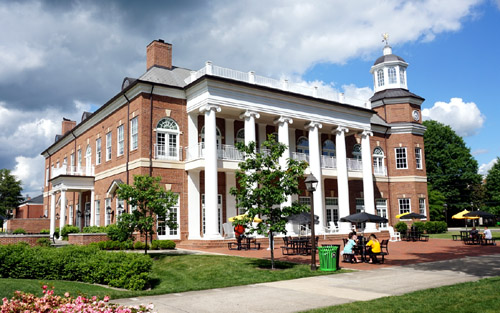 Randolph-Macon College's Brock Commons. Randolph-Macon College's Brock Commons. |
 |
Randolph-Macon College founded, originally located in Boydton, Virginia. Named for Virginia Statesman John Randolph and North Carolina Statesman Nathaniel Macon. Randolph-Macon is the oldest continuously operating Methodist college in the United States. John Preston Clarke (1831-1932), a free black man and prominent minister, was raised in a Quaker Community east of Montpelier. Ordained as a minister in 1867, Clarke helped to establish six black churches in Hanover County: Abner in the Rockville area; Bethany, Montpelier; Ebenezer, Beaverdam; Greenwood, Ashland area; St. James, Coatesville; and Shiloh, Ashland.
(Hanover County Historical Society Bulletin No. 100) |
|
The railroad comes to Hanover County |

February 13: First 20 miles of the Richmond, Fredericksburg and Potomac Railroad (RF&P) are opened. Locomotives with a top speed of 10mph steam through Hanover County for the first time.
(A Brief History of the Richmond, Fredericksburg and Potomac Railroad, pp. 5 – 9) |
 |
December 20: First 22 miles of the Louisa Railroad, connecting Frederick's Hall in Louisa County with Hanover Junction, open. Most of this railroad operates in Hanover County.
(Chessie’s Road, pp. 21 – 23) |
Over the course of the war, some 250,000 men face each other on Hanover soil. Two major campaigns sweep through Hanover County, as well as several skirmishes.
May 27: Battle of Hanover Court House, elements of Union Brig. Gen. Fitz John Porter's V Corps engage a smaller Confederate force under Col. Lawrence O'Bryan Branch, three miles south of Hanover Courthouse. The Union is victorious, retiring Confederate troops flee past the Courthouse. Hanover County Clerk Robert O. Doswell is arrested by Federal troops, released after three months. |
 |
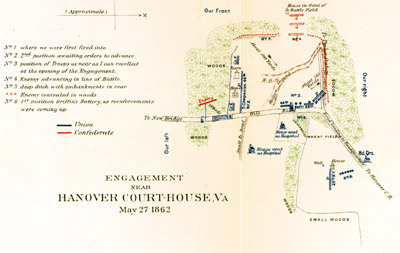 US War Department illustration of the Engagement at Hanover Court-House, 1895 US War Department illustration of the Engagement at Hanover Court-House, 1895 |
June 25 - July 1: Peninsula Campaign, Seven Days Battle, "Seven battles in seven days," two of which are in Hanover County: The Battle of Beaver Dam Creek in Mechanicsville takes place on June 26, and the Battle of Gaines Mill is fought on June 27.
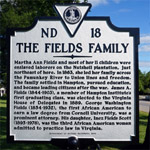 |
 |
Martha Ann Fields and most of her eleven children were enslaved laborers on Nutshell Plantation, just northeast of the historic Hanover Courthouse. In 1863, she led much of her family across the Pamunkey River to Union lines and freedom. They made it to Fort Monroe and settled in Hampton, pursued education, and became leading citizens after the war. In June of 2020, an historic marker was erected on the Courthouse Green in honor of Martha Ann Fields and her family. |
May 4 - June 24: Overland Campaign. Two major battles are fought in Hanover County: The Battle of North Anna on May 23-26, and the Battle of Cold Harbor from May 31 to June 12. |
 |
Randolph-Macon College is relocated to Ashland, a move made necessary by the ravages of the Civil War: As a "burned courthouse county," much of Hanover County's infrastructure has been destroyed. |
|
There is more Hanover County history to come...
|
|
 |
|
|
|
|